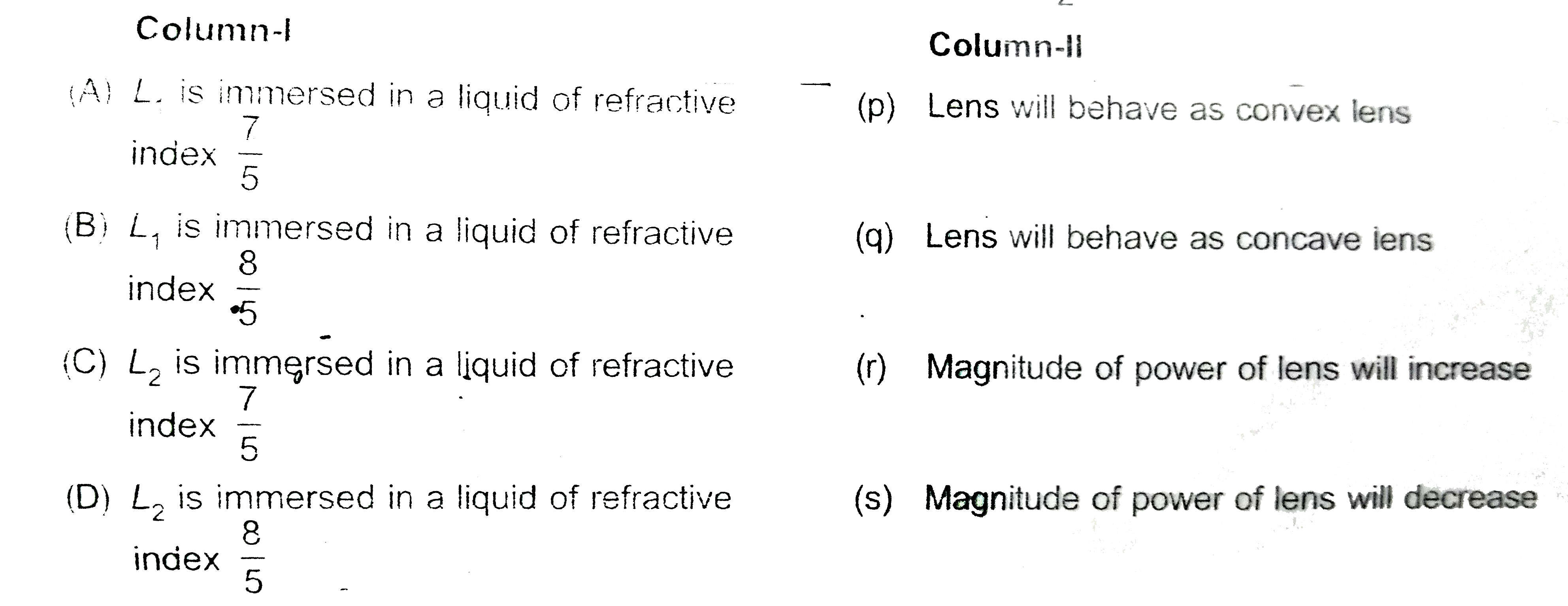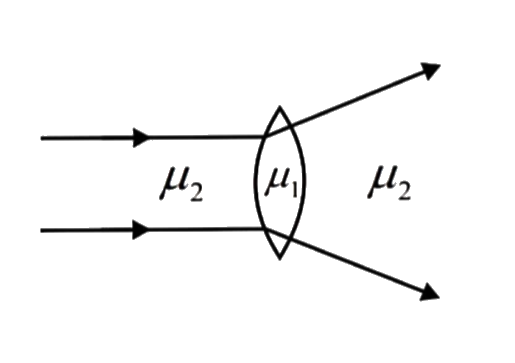Two light waves having the same wavelength λ in vacuum are in phase initially. Then the first ray travels a path of length L1 through a medium of refractive index μ1. Then second ray travels a path of length L2 throug a medium of refractive index μ2. The two waves are then combined to observed interference effects. The phase difference between the two, when they interfere, is
2πλ(n2L1−n1L2)
2πλ(n1L1−n2L2)
2πλ(L2n1−L1n2)
2πλ(L1n1−L2n2)
To find the phase difference between two light waves that have traveled through different media, we can follow these steps:
1. Identify the Given Parameters:
- Wavelength in vacuum: λ
- Path length of the first wave in medium 1: L1
- Refractive index of medium 1: μ1
- Path length of the second wave in medium 2: L2
- Refractive index of medium 2: μ2
2. Calculate the Optical Path Lengths:
- The optical path length for the first wave traveling through medium 1 is given by:
Optical Path Length1=μ1⋅L1
- The optical path length for the second wave traveling through medium 2 is given by:
Optical Path Length2=μ2⋅L2
3. Determine the Path Difference:
- The path difference (Δx) between the two waves when they are combined is:
Δx=Optical Path Length1−Optical Path Length2
- Substituting the expressions for the optical path lengths:
Δx=(μ1⋅L1)−(μ2⋅L2)
4. Relate Path Difference to Phase Difference:
- The phase difference (Δϕ) between the two waves is related to the path difference by the formula:
Δϕ=2πλ⋅Δx
- Substituting the expression for Δx:
Δϕ=2πλ⋅(μ1⋅L1−μ2⋅L2)
5. Final Expression for Phase Difference:
- Thus, the phase difference between the two waves when they interfere is:
Δϕ=2πλ(μ1L1−μ2L2)
- Wavelength in vacuum: λ
- Path length of the first wave in medium 1: L1
- Refractive index of medium 1: μ1
- Path length of the second wave in medium 2: L2
- Refractive index of medium 2: μ2
- The optical path length for the first wave traveling through medium 1 is given by:
Optical Path Length1=μ1⋅L1
- The optical path length for the second wave traveling through medium 2 is given by:
Optical Path Length2=μ2⋅L2
- The path difference (Δx) between the two waves when they are combined is:
Δx=Optical Path Length1−Optical Path Length2
- Substituting the expressions for the optical path lengths:
Δx=(μ1⋅L1)−(μ2⋅L2)
- The phase difference (Δϕ) between the two waves is related to the path difference by the formula:
Δϕ=2πλ⋅Δx
- Substituting the expression for Δx:
Δϕ=2πλ⋅(μ1⋅L1−μ2⋅L2)
- Thus, the phase difference between the two waves when they interfere is:
Δϕ=2πλ(μ1L1−μ2L2)
Topper's Solved these Questions
Similar Questions
If light travels a distance of 5 m in a medium of refractive index μ, then equivalent path in vaccum it would travel in same time is
View SolutionA lens made of material of Refractive index μ2 is surrounded by a medium of Refractive Index μ1. The focal length f is related as
View SolutionA lens made of material of Refractive index μ2 is surrounded by a medium of Refractive Index μ1. The focal length f is related as
View SolutionLight of wavelength λ0 in air enters a medium of refractive index n. If two points A and B in this medium lie along the path of this light at a distance x, then phase difference ϕ0 between these two point is
View SolutionTwo parallel rays are travelling in a medium of refractive index μ1=4/3. One of the rays passes through a parallel glass slab of thickness t and refractive index μ2=3/2. The path difference between the two rays due to the glass slab will be
View SolutionA ray of light with wavelength 5000 nm travelling from a medium with refractive index (32) suffers partial reflection and refraction in a medium of refractive index (43). Find wavelength of reflected and refracted ray.
View SolutionA convex lens L1 and a concave lens L2 have refractive index 32. Match the following two columns.

View SolutionA ray of light, travelling in a medium of refractive index 'mu_, is incident at an angle i on a composite transparent plate consisting of three plates of refractive indices μ1,μ2andμ3. The ray emerges from the composite plate into a medium of refractive index μ4, at angle x. Then,
View SolutionLight waves of wave length λ propagate in a medium. If M end N are two points on the wave front and they are separated by a distance λ/4, the phase difference between them will be (in radian)
View SolutionA thin bi-convex lens made out of a material of refractive index μ1 is place in a medium of refractive index μ2. A paraxial beam of light, parallel to the principal axis of the lens, is shown in the figure. Based on the ray diagram, we can conclude that

View Solution
